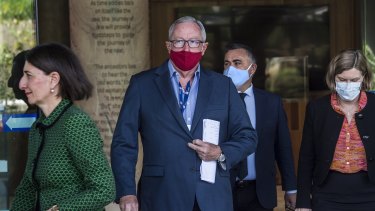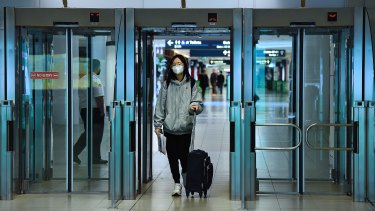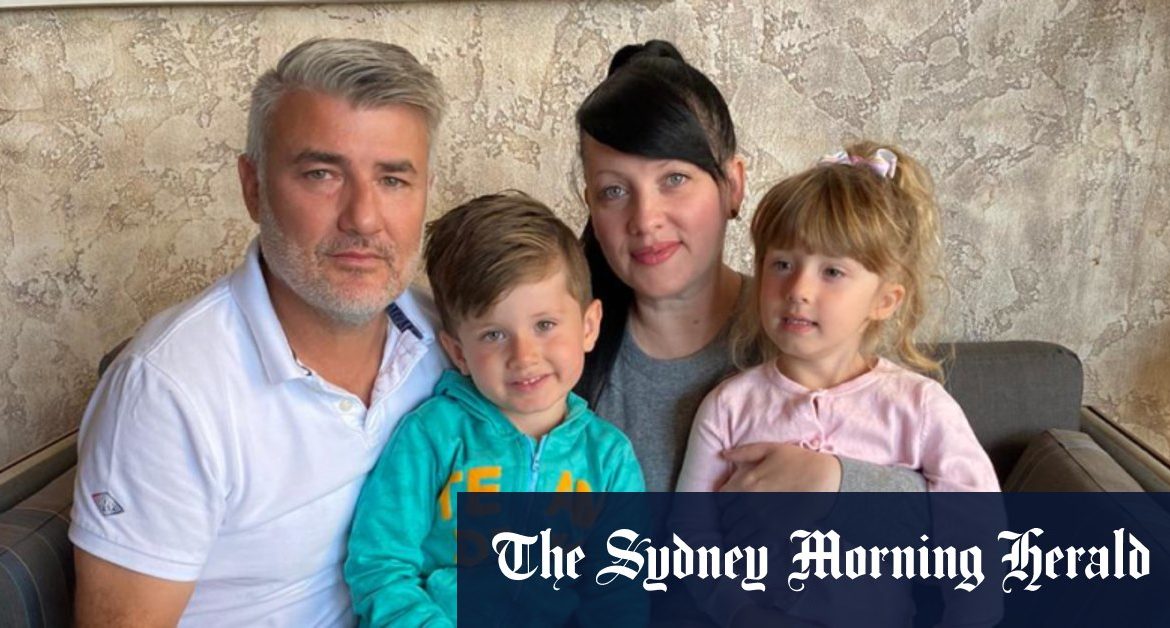Fisher, who had been employed in the UAE for more than a decade, was made redundant mid-year after the economic shock of the pandemic and worked out his required three months’ notice with a flight back booked for September. That was cancelled, as were the next two, including one just before Christmas. With an expired lease on their home, visas about to run out, and their worldly goods on a ship to Australia, the couple are nearing desperation.
Loading
Yet the online abuse they get from unsympathetic countrymen is “horrific”, Walkowsky says. “They talk about us as if we are plague-infested rats. I just feel heartbroken, I don’t understand why people are so nasty about us, and the government just doesn’t seem to care.”
There are thousands more like them. Fifty-year-old Gaynor Reid is desperate to get back from Singapore to see her 76-year-old father, Allan, in Sydney. He has advanced Alzheimer’s and is constantly asking for her, she says. She’d planned to come back on January 3 but could only get a flight to Adelaide, which she cancelled when there was talk of the South Australian border closing. Now she may have to wait until April.
Reid has written an open letter to Prime Minister Scott Morrison, begging him to consider allowing passengers from Singapore – a low-risk country – an exemption from mandatory hotel quarantine in similar fashion to New Zealand. This would not only allow more entries from Singapore but free up limited places in hotel quarantine for other travellers, she says.
The psychological wear and tear on those trapped in an endless, Kafkaesque loop of cancelled flights, relentless uncertainty and involuntary exile is corrosive.
Singapore-based Gaynor Reid wants to return to Sydney to see her father Allan who has Alzheimer’s.
Stranded Australian David Jeffries told the Senate’s COVID-19 inquiry late last year that his family, who’d been trying to get back from Canada for six months, felt like “Schrodinger’s travellers” (a reference to the famous Schrodinger’s cat in the quantum physics conundrum). “We are simultaneously always leaving and never leaving,” Jeffries said.
Prime Minister Scott Morrison undertook in September to try to get “as many people home, if not all of them, by Christmas”.
In a written statement to the Herald and The Age, the Department of Foreign Affairs and Trade (DFAT) says it has helped more than 38,800 Australians return on more than 500 flights, “including 12,500 people on 90 government facilitated flights”, which are operated by Qantas.
But the list of those seeking help to return still stands at more than 37,000 Australians, of whom 4800 are classed as “vulnerable.” Indeed the queue to come home seems to keep replenishing itself even as others finally manage to get a seat back.
All up, DFAT says 440,000 Australians have returned to Australia since people were told to reconsider the need to travel abroad at the start of the pandemic.
But the Australian Border Force gave the Herald and The Age a different figure, saying 280,560 Australian citizens and permanent residents had come into the country between March 20 (when borders closed) and January 10 this year. During the same period, 76,076 foreign nationals also made it in under various classes of exemption.
Ben Saul, professor of international law at Sydney University, says it’s hard to defend decisions to let in people like high-profile international sports stars at a time when so many citizens are stranded abroad. “If it’s so difficult to bring people home why are we letting in the Indian cricket team from the second most infected country in the world?” he asks. Victoria, too, has brought in 1200 tennis players and supporters for the Australian Open.
Saul accuses the government of lacking “political will to give appropriate weight to the citizen and human rights of Australians to return home to their own country”.
Loading
The bottlenecks for would-be returnees stem from the requirement for returning travellers to enter hotel quarantine, which is run by the states and territories. The availability of quarantine places in turn dictates the caps which states seek on the numbers of overseas arrivals. Those caps are agreed at national cabinet, then relayed to the airlines by the federal department of Infrastructure and Transport under Commonwealth air navigation regulations.
Yet the caps themselves are subject to arbitrary variation, as was demonstrated by last week’s decision to abruptly halve them for a month after panic set in among state premiers about the increased infectivity of the UK strain of the coronavirus.
For Sydney, that meant cutting arrivals from 3010 to around 1500 a week, WA dropping from 1025 to 512 a week and Queensland from 1000 to 650 a week.
The knock-on effect means another round of cancelled flights for those waiting to get back from enforced exile, and havoc for airline schedules.
Loading
A source at one major airline told the Herald and The Age that they were now only being allowed to bring in between 25 and 40 passengers per day, on the days when they had permission to land.
“You hear the government saying they are doing all they can to get Aussies home – no they are not, they are not exploring every single avenue”, the source said. “There does not seem to be a level of want from government at any level to genuinely sit down with the industry and say, ‘Listen, we see this is an issue, we are thinking about trying these solutions, how does that work for you guys operationally?'”
The number of empty airline seats coming into the country stood at 30,000 a week in November, the Senate COVID-19 inquiry heard.
The snap imposition of internal borders by states and territories also impacts Australians trying to return home, as domestic travellers forced at short notice into quarantine may dislodge available places for overseas travellers.
Labor’s Penny Wong says the country is “in this mess because … Scott Morrison, for whatever reason, did not want to take responsibility for national quarantine”.

Prime Minister Scott Morrison said in September that he would try and get “as many people home” by Christmas.Credit:Alex Ellinghausen
She says Canberra should fully implement the recommendations of a report by former senior public servant, Jane Halton, which among other measures recommended that the Commonwealth set up a federal quarantine “surge” capacity “in reserve”, perhaps utilising somewhere like the Learmonth RAAF base (in WA) or at immigration detention facilities.
(However Halton has also told the Australian Financial Review this week she thought hotel quarantine was running “very successfully”.)
WA Premier Mark McGowan is pledging to reactivate at national cabinet’s next meeting the idea of using remote Commonwealth facilities like Christmas Island for quarantine, while Victorian premier Dan Andrews has unsuccessfully floated the idea of using defence facilities.
A spokesperson for the Prime Minister’s department says there was currently “no change to the advice” on federal thinking on further sites, adding that “sites need to be picked carefully to ensure they meet the health requirements (eg within reasonable proximity of a tertiary hospital capable of managing a number of seriously ill individuals and other acute care needs at the same time)”.
Canberra says it has already implemented another of Halton’s recommendations, negotiating with the Northern Territory government to expand quarantine capacity at the former Howard Springs labour camp, near Darwin. But those extra places will not balance out the halving of caps in the other states.

NSW Health Minister Brad Hazzard, with Premier Gladys Berejiklian, Deputy Premier John Barilaro and Chief Medical Officer Kerrie Chant, says the government will not be moving quarantine facilities outside of Sydney. Credit:Steven Siewert
The ABF says Christmas Island is not on the table for quarantine, as it’s again running as a detention facility because the ability to “remove unlawful non-citizens from Australia has been curtailed … due to global COVID-19 measures”.
Queensland’s Premier Annastacia Palaszczuk is examining several former regional mining camps as potential quarantine sites, saying some are four-star, and could house the requisite staff to run them on site. Brisbane’s recent scare over the highly infectious UK strain is a major driver of her desire to get quarantine facilities out of the metropolitan area. But the logistics of getting international arrivals into more remote parts of the state are likely to present a challenge.
In NSW Health Minister Brad Hazzard remains adamant that the state government will not take quarantine facilities out of Sydney. Not least among the obstacles, he says, is that the state has the largest quarantine intake, requiring some 3500 health, police and other staff to manage it every day.
It’s a stark illustration of the reality that the states, not the Commonwealth, have most of the manpower to keep current quarantine arrangements operating.
Despite this Saul says, “under the constitution the federal government has clear powers to deal with quarantine issues and if it wanted to pull its finger out, it could do it, it could take over, or supplement, or bolster whatever state and territory quarantine arrangements are there”.

The number of empty airline seats coming into the country stood at 30,000 a week in November, the Senate COVID-19 inquiry heard.Credit:Kate Geraghty
The consular staff of DFAT are working their hardest to achieve what they can within the limit of the caps set by the states, the department says. Its deputy secretary for humanitarian and consular affairs, Tony Sheehan, told the Senate committee in November that the operation to bring Australians home “is the most complex consular effort DFAT has ever undertaken”, with a team inside the department “scouring” for tickets to try and match them to people who have sought consular help.
DFAT told the Herald and The Age it has more “facilitated flights” planned for coming weeks to bring vulnerable Australians back from the UK, India, the US and other (unspecified) countries.
But whether it will be quick enough for those at breaking point is another issue. Penny Wong says she’s worried that at this rate “we might not even see [all] these stranded Australians home by Christmas 2021”.
Start your day informed
Our Morning Edition newsletter is a curated guide to the most important and interesting stories, analysis and insights. Sign up here.
Deborah Snow is a senior writer for The Sydney Morning Herald.
Most Viewed in Politics
Loading







